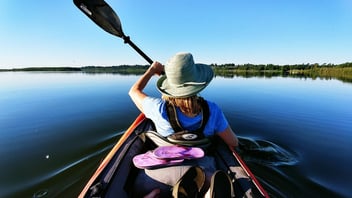Mount Bold Reservoir carp removal
Adelaide’s largest reservoir, Mount Bold, was drained for the first time in 26 years during April/May this year, to allow for inspection and maintenance works in preparation for the planned Mt Bold Reservoir Dam Safety Upgrade.
No water was wasted in the process, with all stored water diverted to the Happy Valley Reservoir and water treatment plant. The draining provided SA Water with an opportunity to remove and utilise approximately 27 tonnes (T) of carp which had accumulated in the reservoir over many years.
Carp are an invasive species, whose feeding habit of sucking sediment into their mouths, retaining food items and ejecting sediment back into the water, contributes to poor water quality. Returning carp to a waterway after fishing is non-compliant with environmental legislation.
The large-scale fish removal was a joint effort by SA Water, SARDI and a commercial River Murray carp fishing company. Fishing commenced when reservoir capacity was at approximately 10% (17.5m at the dam wall) and at the conclusion of fishing activities, water levels were only 0.5m deep at the dam wall. A combination of static net fishing and electro fishing was used. Electro fishing involves placing two probes in the water and passing an electric current between them to temporarily stun the fish in the vicinity. The fish can then be scooped out using nets.
Getting the fishing boats and crews into the reservoir posed a significant challenge, as the boat ramp could not be used whilst the reservoir was at a low level. Cranes were used to lower boats into and out of the water, with fishing personnel transferred to the boats using a work box. Once caught, fish were kept in tubs on the vessel, which were then transferred to land using the work box. Dead fish, a total of 5.7T, were moved to skip bins, which were transported daily for composting. Live fish were frozen the same day in an onsite shipping container freezer.
At the beginning of the project, two small loads of carp were transported to the Sydney Fish markets for consumption; at this point the water was deep, so there was no mud on the fish. As water levels decreased, the fish became muddy rendering them unsuitable for human consumption. Furthermore, COVID-19 restrictions limited cross border travel of fish due to limited transport options. 18T of carp were diverted to processing into liquid and pelletised fertiliser. This approach had a better environmental outcome by diverting fish waste from landfill.
Prior to the project, it was estimated that the reservoir contained 25T of fish. This was based on doubling the amount of carp previously removed from Kangaroo Creek Reservoir, which is approximately half the size. The final removal tally wasn’t far off this estimate, with just over 27T of fish removed- the vast majority being introduced species:
- 27,220kg carp
- 58kg redfin
- 4 catfish
- 2 callop
- 2 koi
- 1 goldfish
- 60 turtles
Our turtle friends and small numbers of native fish were released downstream of the reservoir, to see another day. It is thought that approximately 1T of fish remain in the reservoir.
The majority of carp caught were uniform in size (between 6-8kg); there were also a number of 8-10kg carp, which indicates that the carp had been in the reservoir for quite some time. Interestingly, it is thought carp do not reproduce within the reservoir so it is expected that fish numbers will take a significant amount of time to increase, as carp can only enter the reservoir as eggs through the inlet screens from water that is pumped from the River Murray. Overall, the fishing activities were a great success, with work carried out safely, increased reservoir water quality, and all fish caught being either consumed or utilised as a resource.
Katherine Reid is Senior Planner Wastewater Assets at SA Water.


